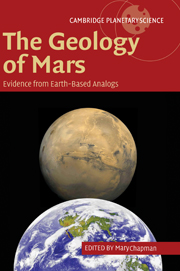Refine listing
Actions for selected content:
17000 results
9 - Surface morphology and origin of outflow channels in the Valles Marineris region
-
-
- Book:
- Megaflooding on Earth and Mars
- Published online:
- 04 May 2010
- Print publication:
- 24 September 2009, pp 172-193
-
- Chapter
- Export citation
3 - A review of open-channel megaflood depositional landforms on Earth and Mars
-
-
- Book:
- Megaflooding on Earth and Mars
- Published online:
- 04 May 2010
- Print publication:
- 24 September 2009, pp 33-49
-
- Chapter
- Export citation
Plate section
-
- Book:
- Megaflooding on Earth and Mars
- Published online:
- 04 May 2010
- Print publication:
- 24 September 2009, pp -
-
- Chapter
- Export citation
2 - Channel-scale erosional bedforms in bedrock and in loose granular material: character, processes and implications
-
-
- Book:
- Megaflooding on Earth and Mars
- Published online:
- 04 May 2010
- Print publication:
- 24 September 2009, pp 13-32
-
- Chapter
- Export citation
6 - The morphology and sedimentology of landforms created by subglacial megafloods
-
-
- Book:
- Megaflooding on Earth and Mars
- Published online:
- 04 May 2010
- Print publication:
- 24 September 2009, pp 78-103
-
- Chapter
- Export citation
1 - Overview of megaflooding: Earth and Mars
-
-
- Book:
- Megaflooding on Earth and Mars
- Published online:
- 04 May 2010
- Print publication:
- 24 September 2009, pp 1-12
-
- Chapter
- Export citation
Contents
-
- Book:
- Megaflooding on Earth and Mars
- Published online:
- 04 May 2010
- Print publication:
- 24 September 2009, pp v-vii
-
- Chapter
- Export citation
13 - Megaflood sedimentary valley fill: Altai Mountains, Siberia
-
-
- Book:
- Megaflooding on Earth and Mars
- Published online:
- 04 May 2010
- Print publication:
- 24 September 2009, pp 243-264
-
- Chapter
- Export citation
10 - Floods from fossae: a review of Amazonian-aged extensional–tectonic megaflood channels on Mars
-
-
- Book:
- Megaflooding on Earth and Mars
- Published online:
- 04 May 2010
- Print publication:
- 24 September 2009, pp 194-208
-
- Chapter
- Export citation
12 - Criteria for identifying jökulhlaup deposits in the sedimentary record
-
-
- Book:
- Megaflooding on Earth and Mars
- Published online:
- 04 May 2010
- Print publication:
- 24 September 2009, pp 225-242
-
- Chapter
- Export citation
16 - Dynamics of fluid flow in Martian outflow channels
-
-
- Book:
- Megaflooding on Earth and Mars
- Published online:
- 04 May 2010
- Print publication:
- 24 September 2009, pp 290-311
-
- Chapter
- Export citation
List of contributors
-
- Book:
- Megaflooding on Earth and Mars
- Published online:
- 04 May 2010
- Print publication:
- 24 September 2009, pp viii-x
-
- Chapter
- Export citation
8 - Floods from natural rock-material dams
-
-
- Book:
- Megaflooding on Earth and Mars
- Published online:
- 04 May 2010
- Print publication:
- 24 September 2009, pp 128-171
-
- Chapter
- Export citation
Frontmatter
-
- Book:
- Megaflooding on Earth and Mars
- Published online:
- 04 May 2010
- Print publication:
- 24 September 2009, pp i-iv
-
- Chapter
- Export citation
11 - Large basin overflow floods on Mars
-
-
- Book:
- Megaflooding on Earth and Mars
- Published online:
- 04 May 2010
- Print publication:
- 24 September 2009, pp 209-224
-
- Chapter
- Export citation
15 - Jökulhlaups from Kverkfjöll volcano, Iceland: modelling transient hydraulic phenomena
-
-
- Book:
- Megaflooding on Earth and Mars
- Published online:
- 04 May 2010
- Print publication:
- 24 September 2009, pp 273-289
-
- Chapter
- Export citation

Observing Variable Stars
- A Guide for the Beginner
-
- Published online:
- 22 September 2009
- Print publication:
- 27 April 1989

Celestial Objects for Modern Telescopes
- Practical Amateur Astronomy Volume 2
-
- Published online:
- 22 September 2009
- Print publication:
- 26 September 2002

Globular Cluster Systems
-
- Published online:
- 21 September 2009
- Print publication:
- 13 May 1998

The Geology of Mars
- Evidence from Earth-Based Analogs
-
- Published online:
- 18 September 2009
- Print publication:
- 17 May 2007
